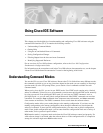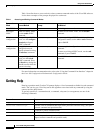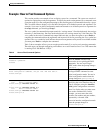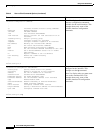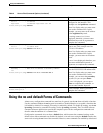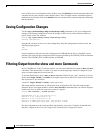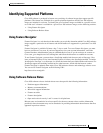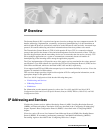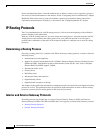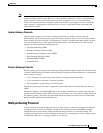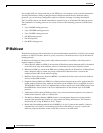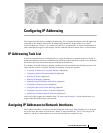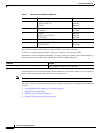
IPC-1
Cisco IOS IP Configuration Guide
IP Overview
The Internet Protocol (IP) is a packet-based protocol used to exchange data over computer networks. IP
handles addressing, fragmentation, reassembly, and protocol demultiplexing. It is the foundation on
which all other IP protocols (collectively referred to as the IP Protocol suite) are built. A network-layer
protocol, IP contains addressing and control information that allows data packets to be routed.
The Transmission Control Protocol (TCP) is built upon the IP layer. TCP is a connection-oriented
protocol that specifies the format of data and acknowledgments used in the transfer of data. TCP also
specifies the procedures that the networking devices use to ensure that the data arrives correctly. TCP
allows multiple applications on a system to communicate concurrently because it handles all
demultiplexing of the incoming traffic among the application programs.
The Cisco implementation of IP provides most of the major services contained in the various protocol
specifications. Cisco IOS software also provides the TCP and User Datagram Protocol (UDP) services
called Echo and Discard, which are described in RFCs 862 and 863, respectively.
Cisco supports both TCP and UDP at the transport layer, for maximum flexibility in services. Cisco also
supports all standards for IP broadcasts.
This overview chapter provides a high-level description of IP. For configuration information, see the
appropriate chapter in this publication.
The Cisco IOS IP Configuration Guide has the following three parts:
• IP Addressing and Services
• IP Routing Protocols
• IP Multicast
For information on other network protocols, refer to the Cisco IOS AppleTalk and Novell IPX
Configuration Guide and Cisco IOS Apollo Domain, Banyan VINES, DECnet, ISO CLNS, and XNS
Configuration Guide.
IP Addressing and Services
IP addressing features such as Address Resolution Protocol (ARP), Next Hop Resolution Protocol
(NHRP), and Network Address Translation (NAT) are described in the “Configuring IP Addressing”
chapter. Dynamic Host Configuration Protocol (DHCP) is described in the “Configuring DHCP”
chapter.
IP services such as IP access lists, Internet Control Message Protocol (ICMP), Hot Standby Router
Protocol (HSRP), IP accounting, performance parameters, and MultiNode Balancing (MNLB)
Forwarding Agent are described in the “Configuring IP Services” chapter.



